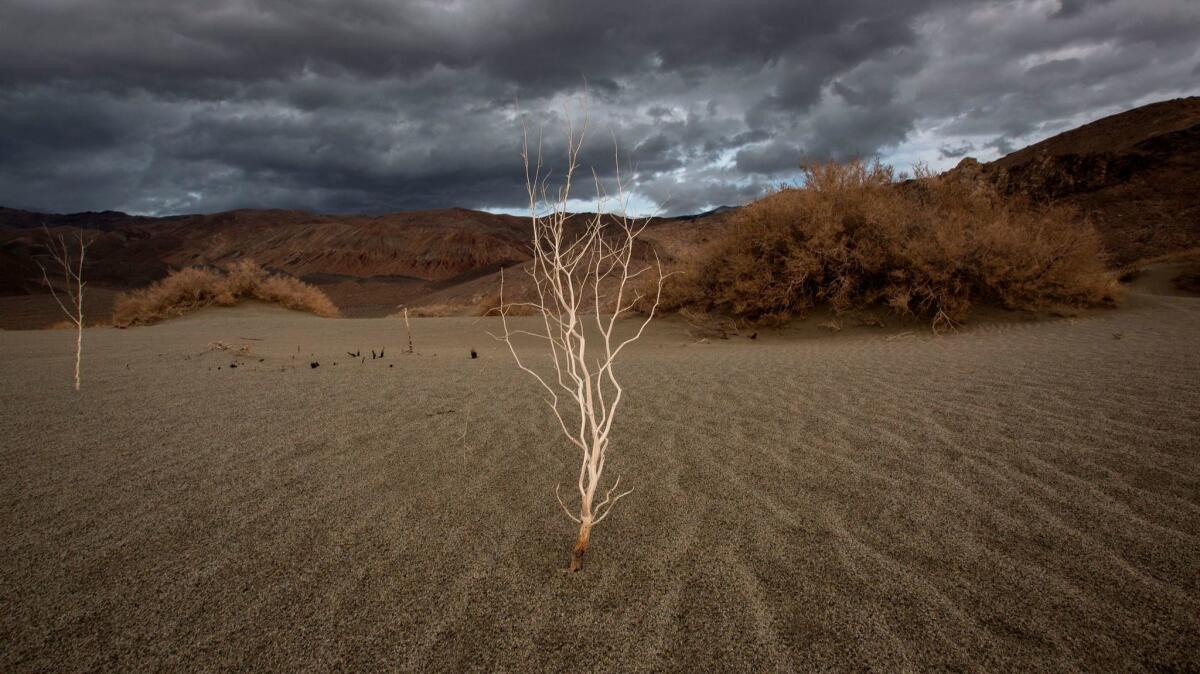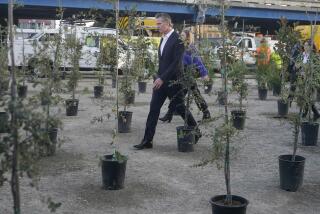Column: Study indicates that climate change will wreak havoc on California agriculture

The California we know is the breadbasket of the nation, producing more than two-thirds of the country’s fruits and nuts, including almonds, pistachios, oranges, apricots, nectarines and prunes, and more than a third of its vegetables, including artichokes, broccoli, spinach and carrots. It’s all valued at more than $50 billion a year.
That’s the assessment of a recent paper by a University of California team led by Tapan Pathak of UC Merced. But the researchers focused on a different aspect of California agriculture: You can kiss much of it goodbye because of climate change.
The paper, published in the journal Agronomy last month, is the most thorough review of the literature on the regional impact of climate change in recent memory. It makes grim reading.
Among the chief manifestations of climate change will be changes in precipitation patterns, leading to more drought and more flooding, and spottier water storage. Generally warmer temperatures, not to mention more frequent and severe heat waves, will reduce yields of wine grapes, strawberries and walnuts; shorter chill seasons will make vast areas no longer suitable for chestnuts, pecans, apricots, kiwis, apples, cherries and pears. Plant diseases and pests will move into regions where they haven’t been a problem before.
The increased rate and scale of climate change is beyond the realm of experience for the agricultural community.
— UC Merced agronomist Tapan Pathak, et al.
Few crops will escape the dire effects of the transformation. Seasonal chilling is necessary to break some crops out of dormancy and launch pollination and flowering. By the end of this century, according to a study cited by the UC paper, the shrinking winter chill period will reduce the acreage of the Central Valley suitable for chestnut, pecan and quince by 22%, and for apricot, peach, nectarine and walnut by more than half. By 2000, only 4% of the Central Valley was suitable for apples, cherries and pears, but none of that will be left by 2060 under almost any climate change scenario.
Put it all together, and the prospect is for a dramatic change in the mix of California produce and overall output. The UC paper foresees a decline of more than 40% in avocado yields, and as much as 20% in almonds, table grapes, oranges and walnuts. (Wine grape yields will be generally unaffected, but their quality might be compromised.)
Disruption is already evident with some crops in some regions, the paper notes — in truth, dealing with natural variations in weather always has been the hallmark of California farming — but that’s nothing compared to what lies ahead. “The increased rate and scale of climate change,” the researchers say, “is beyond the realm of experience for the agricultural community.”
In terms of which areas might be affected the most, “it is hard to point out a single region,” Pathak told me, in part because California is a huge state comprising at least two large and distinct regions, north and south.
“Central Valley chill-sensitive perennial crops, especially the ones that require a higher number of chill hours, are vulnerable to climatological changes,” Pathak says. “Heat-sensitive crops, such as strawberries and vegetables, drive vulnerability in coastal areas. Heat-stress-related vulnerability would greatly impact desert regions.”
California hasn’t been blind to the potential effects of climate change. Indeed, the UC paper tracks closely with the findings from a consortium on long-term impacts convened by the Department of Food and Agriculture in 2013. The state has been on the forefront of water and energy conservation, on the move toward renewable energy sources and on the reduction of greenhouse gas emissions.
Awareness of the consequences of inaction may help to explain why California Gov. Jerry Brown has emerged as a leader in the fight against climate change. He understands the economic devastation that will result from continued climatic warning, as well as its impact on food security and health.
Last June, when President Trump announced the U.S. withdrawal from the Paris climate accord, Brown let him have it with both rhetorical barrels: “This is a crazy decision,” he said during an appearance on CNN. “It’s against the facts, it’s against science, it’s against reality itself.” If we don’t “decarbonize our future,” Brown said, “people are going to die, habitat will be destroyed, seas will rise, insects will spread in areas they’ve never been before. This is not a game.”
The state’s Natural Resources Agency also has published a road map for dealing with some impacts, including on agriculture. The document acknowledges the prospect of decreased crop yields, declines in water quality and increased pest pressures.
At the moment, the agency has focused more on giving growers and dairy farmers tools for managing the immediate impacts of climate change. The state Department of Food and Agriculture has $67.5 million, provided through the state’s greenhouse gas cap-and-trade program, to help growers with water efficiency and emission-reduction projects.
“Growers told us at the climate change consortium that they deal with a changing climate every day,” says Amrith Gunasekara, head of the Office of Environmental Farming and Innovation at the Department of Food and Agriculture. “They have to watch out for rain and cold weather, they have to watch out for frost.” But with the exception of the recent multiyear drought, “they’re not experiencing climate change to a drastic enough level that they have adaptation mechanisms at this point.”
One obstacle to long-term planning is that projections of conditions a half-century in the future or more are inherently uncertain, except in general terms. “There’s a general sense that it’s going to get hotter in the south and the Central Valley and warmer in the north,” Gunasekara told me. “They want to incorporate these changes in their business models into the future, but they say that for them to really understand how this is going to impact their businesses, they need to know what the cost of crop relocation will be.”
It may yet be too early to bring the consequences of climate change home to the agricultural sector, Gunasekara says. “For temperature, I think it’s going to take another 1- or 2-degree change,” which is expected to occur over the next 50 to 100 years.
The transformation that does occur will be felt far beyond California’s borders, the UC paper observed. Changes in the state’s crop output “would not only translate into national food security issues, but also economic impacts that could disrupt state and national commodity systems.” As a result of rising global population and increasing biofuel demand, the paper says, global crop production needs to double by 2050, but California’s ability to contribute to that supply is at risk.
The effects of climate change fall into two main interrelated categories in California, as they do most everywhere: temperature and water. Average maximum and minimum temperatures have been rising in the state, leading to less cooling and more heat waves, especially in inland areas such as the Central Valley.
That disrupts precipitation patterns and the water supply. In the winter of 2013-2014, the state suffered its worst drought since records started being kept in 1886. Over the last 30 years, droughts have been getting more severe and years of water surplus rarer. Both the abundance of precipitation and its seasonality have been changing for the worse.
More rain and snowfall in warmer periods means faster snowmelt, which in turn leads to earlier filling of reservoirs, more uncaptured runoff, and consequently, worse winter flooding and summer shortages. The paper cites Department of Water Resources figures showing that the peak runoff in the Sacramento River watershed has shifted earlier by a full month, to mid-March from mid-April, since 1955. That reduces the effectiveness of levees, dams and floodgates that were designed and built for outdated weather patterns.
UC Merced’s Pathak says growers and state planners will need to deal with short-term impacts as well as the long-term ones. The near term involves greater variability in weather, namely more droughts and floods. “We need to be prepared to mitigate risks to agriculture due to these extreme events,” he told me. That translates into better flood control, more efficient irrigation and more water storage.
The longer term requires a more strategic approach. California simply won’t be as suitable — or suitable at all — for some crops that have been identified with California farming for decades. Whatever the strategy, California agriculture is going to look very different at the end of this century than it does today, and the time to start taking stock is now.
Keep up to date with Michael Hiltzik. Follow @hiltzikm on Twitter, see his Facebook page, or email [email protected].
Return to Michael Hiltzik’s blog.







